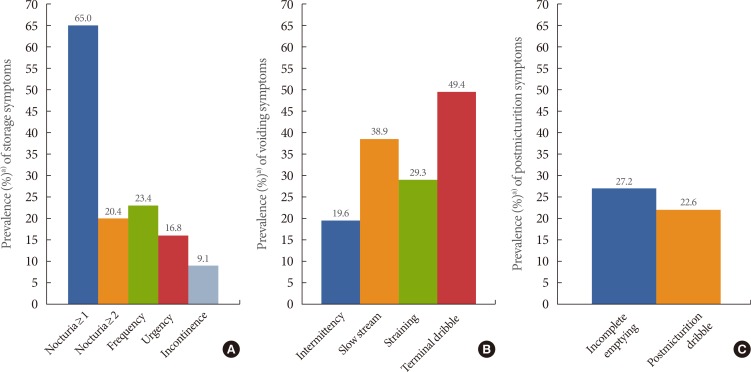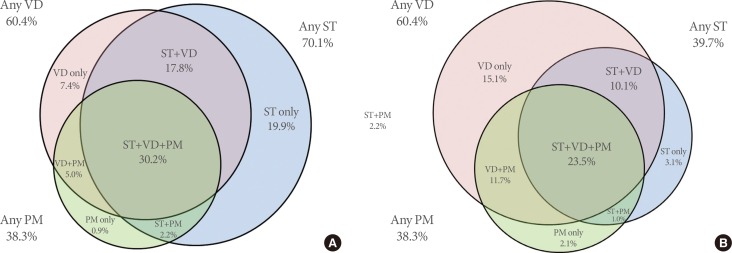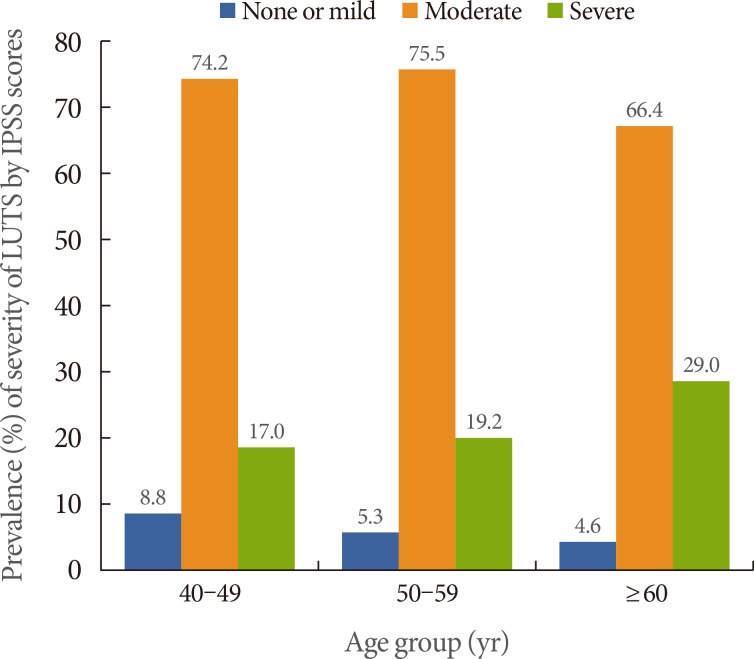Abstract
Purpose
The aim of this study was to evaluate the prevalence of lower urinary tract symptoms (LUTS) among Korean men aged ≥40 years.
Methods
We performed a population-based, cross-sectional door-to-door survey on a geographically stratified random sample of men aged ≥40 years. All respondents were asked about the presence of individual LUTS using a questionnaire based on 2002 International Continence Society definitions. For comparison, we also defined nocturia as two or more nocturnal micturitions per night. The International Prostate Symptom Score (IPSS) questionnaire was used to assess LUTS severity.
Results
Responses from 1,842 subjects were analyzed. The overall prevalence of LUTS was 83.4%. Storage LUTS (70.1%) were more prevalent than voiding (60.4%) or postmicturition LUTS (38.3%). When nocturia was defined as two or more nocturnal micturitions per night, voiding symptoms became most prevalent (storage, 39.7%; voiding, 60.4%; and postmicturition, 38.3%). More than 90% of our population described the severity of their urinary symptoms as moderate (8-19) or severe (20-35). The prevalence and severity of LUTS increased with age.
Conclusions
LUTS are highly prevalent among Korean men, and its prevalence increases with age. Increased public awareness and a larger number of treatment options are needed to appropriately manage symptoms and their consequences.
Keywords: Lower urinary tract symptoms, Prevalence, Epidemiologic studies
INTRODUCTION
According to the 2002 International Continence Society (ICS) definitions, lower urinary tract symptoms (LUTS) include a variety of storage, voiding, and postmicturition symptoms [1]. LUTS are recognized as a common condition in men aged ≥40 years, and its prevalence increases with age [2,3,4]. Several epidemiologic studies have focused on LUTS in Korea [5,6,7,8,9,10], as well as in other Asian [11,12,13] and Western countries [14,15,16,17,18]. However, the true prevalence of LUTS is difficult to determine because most studies have examined specific symptoms related to benign prostatic hyperplasia [8,13], urinary incontinence [7,9,10,14], or overactive bladder [5,6,12,15,17,18] rather than LUTS in general. Few prevalence studies have used the 2002 ICS symptom definitions for LUTS. In addition, there are considerable differences across epidemiologic studies of LUTS, and reported prevalence rates for male populations have ranged from 13% to 67% [5,19,20]. These differences have been attributed to inconsistencies in questionnaires used for symptom assessment, survey method, and study population among studies [21]. The prevalence of LUTS is also likely to vary across regions, races, and cultures.
Therefore, we conducted an epidemiologic survey to obtain more comprehensive data on LUTS in Korean men using the 2002 ICS definitions. The purpose of this study was to examine the prevalence of LUTS among men aged ≥40 years in a Korean population sample.
MATERIALS AND METHODS
population-based, cross-sectional door-to-door survey of men aged ≥40 years was conducted in Korea to examine the prevalence of LUTS. After obtaining informed consent, interviews were conducted using a questionnaire that was originally developed for previous EPIC study [20]. The original questionnaire was written in English (Supplementary material) and was translated and revised by linguists, statisticians, and clinicians into an appropriate Korean version [5]. All data were collected via individual face-to-face interviews, usually in the respondent's home. The interviewers received training and were regularly tested to maintain consistency and quality control. This study was approved by the Samsung Medical Center Institutional Review Board.
Survey Sampling
Participants were recruited from five Korean provinces (Seoul, Busan, Daegu, Daejeon, and Gwangju). A random sample was acquired through the Post and Address Registry of Korea using a two-stage sampling method. Households with a residence address number were sampled first, followed by a sampling of male patients ≥40 years within these households. Men who reported having a urinary tract infection were excluded from this survey.
Participant Questionnaires
All respondents were asked about demographics, the presence of individual LUTS using 2002 ICS definitions, and symptom severity, as per the International Prostate Symptom Score (IPSS) [1,22]. The questionnaire used to evaluate LUTS in this study included symptoms of storage (nocturia, frequency, urgency, or incontinence [urgency, stress, mixed, and other]); voiding (intermittency, slow stream, straining, or terminal dribble); and postmicturition (incomplete emptying or postmicturition dribble). The response options for most LUTS were measured on a 6-point Likert scale (i.e., "not at all," "less than 1 time in 5," "less than half the time," "about half the time," "more than half the time," and "almost always"). The 2002 ICS defined nocturia as waking to void one or more times per night [1]. For comparison, we established the second definition of nocturia as two or more nocturnal micturitions per night. Participants who reported experiencing both urgency urinary incontinence and stress urinary incontinence were considered as having "mixed urinary incontinence." Participants who reported experiencing involuntary urinary leakage but neither urgency urinary incontinence nor stress urinary incontinence were considered as having "other urinary incontinence." Participants who responded at least or more than "less than 1 time in 5" to a question were classified as experiencing the symptom.
The IPSS was used to assess LUTS severity, which was classified as none (0), mild (1-7), moderate (8-19), or severe (20-25).
Sample Size
We referred to the study by Lee et al. [5] that reported a 69.4% prevalence rate of at least one LUTS in men aged ≥40 years. We calculated that, after including 1,401 participants, we would be able to achieve a prevalence rate of 70% with a 95% (±2.4%) confidence interval. Assuming an incomplete response rate of 20%, the study required a total of 1,812 participants.
Statistical Analysis
Descriptive statistics were used to present demographic data and prevalence with a 95% confidence interval for individual LUTS. Data were summarized using mean±standard deviation for continuous variables and frequency and proportion for categorical variables. To account for the underlying sampling frame and to provide representative population prevalence estimates, the sample population was weighted by age group, household size, and province size. Prevalence of LUTS was stratified by age into three groups: 40-49, 50-59, and ≥60 years. We performed all statistical analyses using the statistical software package R ver. 2.11.1 (R Foundation for Statistical Computing, Vienna, Austria).
RESULTS
A total of 6,873 men were contacted, and 1,842 men agreed to participate in the study, resulting in a response rate of 26.8%. The mean respondent age was 52.5±9.0 years (range, 40-78 years). Demographic data for respondents are presented in Table 1. Most participants were married, and about three-quarters had college education or higher.
Table 1.
Demographic data and medical comorbidities of the participants
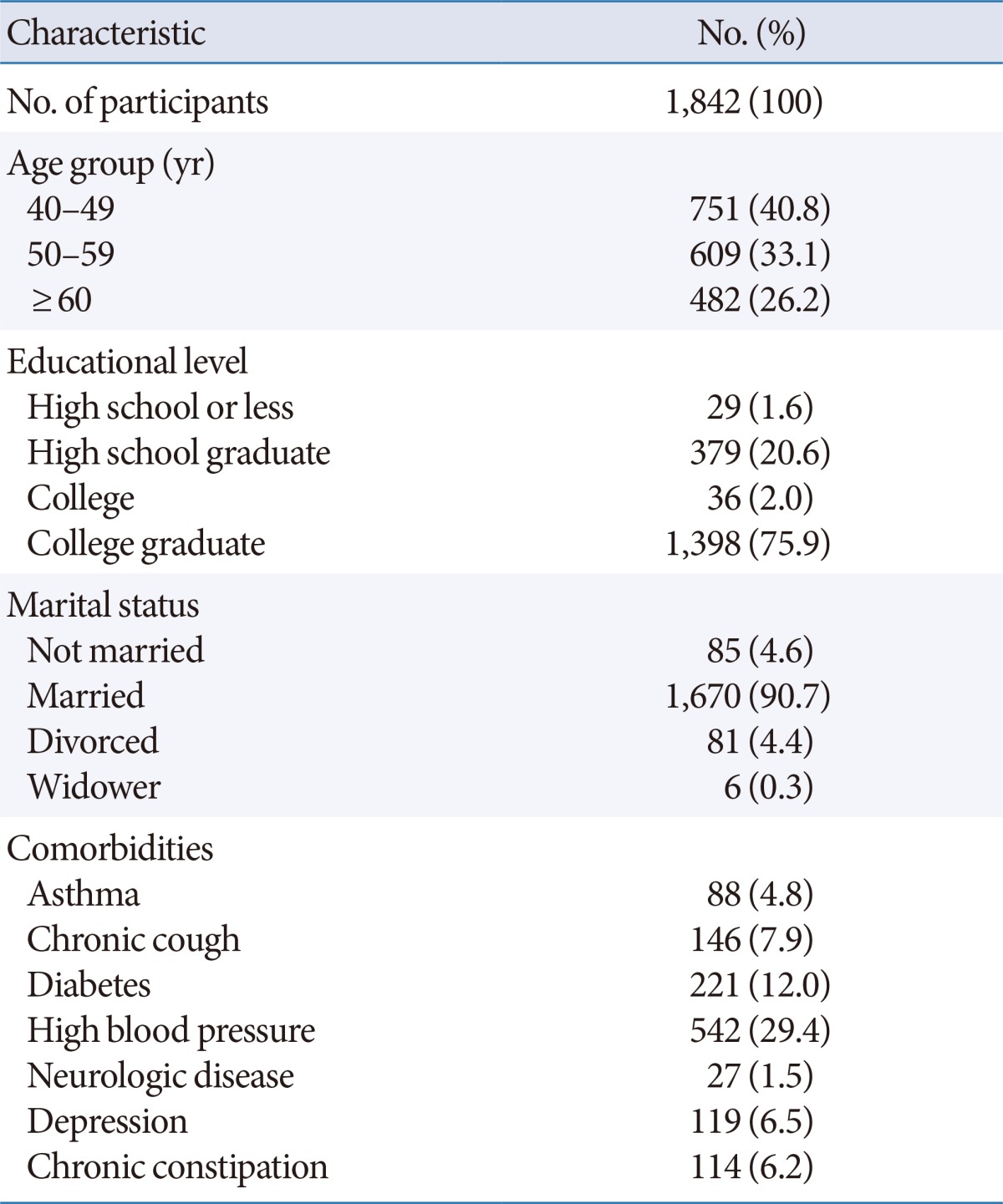
The prevalence of LUTS in the survey population is shown in Table 2. Of the respondents, 83.4% (1,536) reported having at least one LUTS. The prevalence of at least one LUTS tended to increase with age: from 78.3% for men aged 40-49 years to 89.6% for men aged ≥60 years. Storage symptoms were more prevalent than voiding or postmicturition symptoms. Nocturia (65.0%) was the most common storage symptom among respondents, followed by frequency (23.4%) (Fig. 1A). The most common voiding symptom was terminal dribble (49.4%), and the most common postmicturition symptom was incomplete emptying (27.2%) (Fig. 1B, C). Combined storage and voiding symptoms were the most frequently reported combination (48.0%), and 30.2% participants reported experiencing all three categories of LUTS (Fig. 2A). When the definition of nocturia was changed to reflect two or more nocturnal micturitions per night, the prevalence of nocturia decreased to 20.4%, and the prevalence of any storage symptom decreased to 39.7%. Thus, voiding symptoms became the most prevalent (Fig. 2B). Combined voiding and postmicturition symptoms were the most common combination of LUTS (35.2%), and all three categories of LUTS were reported in 23.5% of respondents when using this refined definition.
Table 2.
Prevalence of LUTS by age
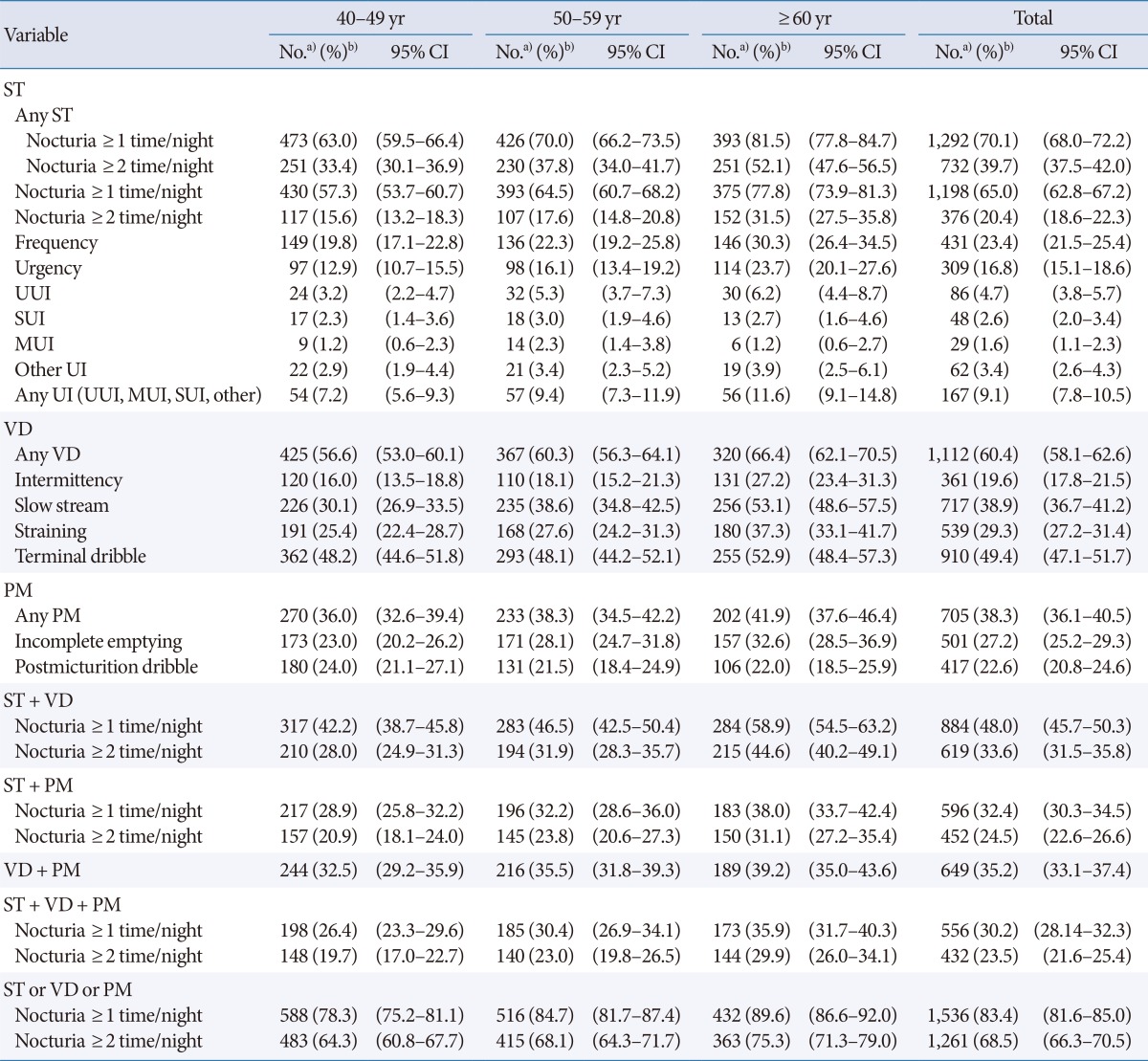
LUTS, lower urinary tract symptoms; CI, confidence interval; ST, storage symptom; VD, voiding symptom; PM, postmicturition symptom; MUI, mixed urinary incontinence; SUI, stress urinary incontinence; UI, urinary incontinence; UUI, urgency urinary incontinence.
a)Unweighted. b)Weighted.
Fig. 1.
Prevalence of lower urinary tract symptoms. (A) Storage symptoms, (B) Voiding symptoms, and (C) Postmicturition symptoms. a)Prevalence (%) indicates weighted, %.
Fig. 2.
Prevalence of lower urinary symptom types with nocturia defined as ≥1 nocturnal micturition per night (A), nocturia defined as ≥2 nocturnal micturitions per night (B). ST, storage symptom; VD, voiding symptom; PM, postmicturition symptom.
On the IPSS, 72.6% of participants reported the severity of urinary symptoms as moderate, 20.9% as severe, and 6.5% as none or mild. The severity of LUTS increased with advancing age; 17% of participants aged 40-49 years reported severe LUTS compared with 29% of those aged ≥60 years (Fig. 3).
Fig. 3.
Severity of LUTS by age group. IPSS category: none (0), mild (1-7), moderate (8-19), or severe (20-35). LUTS, lower urinary tract symptoms; IPSS, International Prostate Symptom Score.
DISCUSSION
The present study provides insights into the prevalence of LUTS among Korean men. The questionnaire used in this study was identical to that used in the EPIC study [20], which was the first large population-based examination of the prevalence of LUTS using the 2002 ICS definitions.
Consistent with other epidemiologic studies [3,4,20,23], our results demonstrate that LUTS are highly prevalent in men aged ≥40 years, and that prevalence increases with age. Among our population, 83.4% reported at least one LUTS (storage, voiding, or postmicturition symptom), and 30.2% reported experiencing all three symptoms. These rates are relatively higher than those reported in the EPIC study [20], in which 62.5% and 8.8% reported at least one LUTS and all three symptoms, respectively. The prevalence rates of each individual LUTS in the present study are also higher than those in the EPIC study. In addition, this study found higher prevalence rates of at least one reported LUTS across each age cohort compared with that reported in the EPIC study (40-49 years [78.3%], 50-59 years [84.7%], ≥60 years [89.6%]; EPIC 40-59 years [62.0%], ≥60 years [80.7%]). The reason for the higher overall prevalence of LUTS in the present study is uncertain. However, these differences could be associated with differences in survey methodology (telephone-based research in the EPIC study vs. face-to-face interview in the present study). Furthermore, a previous study suggested that the higher incidence of LUTS may be because of the higher ratio of the transition zone enlargement relative to the entire prostate in Korean men compared with that in Caucasians [24].
Although the ICS defines nocturia as a complaint of an individual who has to wake at night one or more times to void, the relationship between the definition and the disturbance caused by this symptom is unclear. A recent study demonstrated that a majority of people reported feeling disturbed when they experienced at least two voids per night [25]. Therefore, we added an additional definition of nocturia as two or more voids per night. When we used this second definition of nocturia, the prevalence rates in the present study reduced substantially for both at least one LUTS (68.5%) and all three symptoms (23.5%). The previous prevalence of nocturia was because of the high prevalence of storage symptoms, when the definition of nocturia was ≥2 micturitions per night; however, using this new definition, voiding symptoms became the most prevalent LUTS (60.4%). This is attributed to the high prevalence of terminal dribble and slow stream in the Korean population.
More than 90% of our population described the severity of their urinary symptoms as moderate or severe by using the IPSS. As with the prevalence of LUTS, the severity of urinary symptoms also increased with age. These results are similar to those of another Asian multinational survey that reported that almost 90% of Asian men aged ≥40 years had as moderate or severe urinary symptoms [13].
In the present study, face-to-face interviews were performed. In recent years, telephone interviews have increasingly been replaced with face-to-face interviews in studies involving epidemiological inference, because of convenience (usually, computer-assisted telephone interviewing) and savings in time and costs. However, telephone interviews may have problems in uniformity and reproducibility in addition to deviations because of the relative responsiveness of the subjects [26]. Although it is unclear whether face-to-face interviews or telephone surveys are a more reliable or valid assessment of LUTS prevalence, we are convinced that the method used in the present study increased reliability of our data. The main advantage of face-to-face interviews is that the interviewer can clarify any doubt about the meaning of questions and ensure that the responses are properly understood, by repeating or rephrasing the questions if necessary.
Our study has some limitations. First, assessment in the present study, as in most population-based surveys, was based entirely on self-reported symptoms, which are subject to recall bias. Furthermore, none of the outcomes in this study were confirmed by a clinical diagnosis. However, although self-reports may not correspond to results based on clinical diagnosis, a diagnosis verified by a rigorous clinical evaluation would not be feasible in such a large-scale, population-based study. Second, a particular weakness of this study is the low response rate (26.8%). Response rates in previous studies have ranged from 30% to 60% [20,27]. Nonresponse bias would be an issue if the subjects responding to our survey were consistently different from those who did not respond. Unfortunately, the importance of this effect in our survey is unclear because we lack the necessary demographic information on the nonrespondents in order to make a comparison.
Despite those limitations, the results of this study have important implications for clinical practice and emphasize the need for comprehensive assessments in men with LUTS. In particular, these data enrich the literature on LUTS in elderly men.
In conclusion, the present results showed that LUTS are highly prevalent in elderly men in Korea, and that the prevalence of LUTS increases with age. Increased public awareness of these findings is needed to gain a better understanding of LUTS and to appropriately manage and treat the symptoms and consequences.
ACKNOWLEDGEMENTS
This study was supported by the Research Foundation Grant funded by the Korean Urological Association (KUA-2009-003).
Footnotes
No potential conflict of interest relevant to this article was reported.
SUPPLEMENTARY MATERIALS
Urinary symptom questionnaire using 2002 International Continence Society definition with the response option
Supplementary material can be found via http://einj.org/src/sm/einj-18-126-s001.pdf. Urinary symptom questionnaire using 2002 International Continence Society definition with the response option.
References
- 1.Abrams P, Cardozo L, Fall M, Griffiths D, Rosier P, Ulmsten U, et al. The standardisation of terminology of lower urinary tract function: report from the Standardisation Sub-committee of the International Continence Society. Neurourol Urodyn. 2002;21:167–178. doi: 10.1002/nau.10052. [DOI] [PubMed] [Google Scholar]
- 2.Garraway WM, Collins GN, Lee RJ. High prevalence of benign prostatic hypertrophy in the community. Lancet. 1991;338:469–471. doi: 10.1016/0140-6736(91)90543-x. [DOI] [PubMed] [Google Scholar]
- 3.Malmsten UG, Milsom I, Molander U, Norlen LJ. Urinary incontinence and lower urinary tract symptoms: an epidemiological study of men aged 45 to 99 years. J Urol. 1997;158:1733–1737. doi: 10.1016/s0022-5347(01)64113-2. [DOI] [PubMed] [Google Scholar]
- 4.Chong C, Fong L, Lai R, Koh YT, Lau WK, Hartman M, et al. The prevalence of lower urinary tract symptoms and treatment-seeking behaviour in males over 40 years in Singapore: a community-based study. Prostate Cancer Prostatic Dis. 2012;15:273–277. doi: 10.1038/pcan.2011.69. [DOI] [PubMed] [Google Scholar]
- 5.Lee YS, Lee KS, Jung JH, Han DH, Oh SJ, Seo JT, et al. Prevalence of overactive bladder, urinary incontinence, and lower urinary tract symptoms: results of Korean EPIC study. World J Urol. 2011;29:185–190. doi: 10.1007/s00345-009-0490-1. [DOI] [PubMed] [Google Scholar]
- 6.Jo JK, Lee S, Kim YT, Choi HY, Kim SA, Choi BY, et al. Analysis of the risk factors for overactive bladder on the basis of a survey in the community. Korean J Urol. 2012;53:541–546. doi: 10.4111/kju.2012.53.8.541. [DOI] [PMC free article] [PubMed] [Google Scholar]
- 7.Lee KS, Sung HH, Na S, Choo MS. Prevalence of urinary incontinence in Korean women: results of a National Health Interview Survey. World J Urol. 2008;26:179–185. doi: 10.1007/s00345-008-0239-2. [DOI] [PubMed] [Google Scholar]
- 8.Kim S, Jeong JY, Choi YJ, Kim DH, Lee WK, Lee SH, et al. Association between lower urinary tract symptoms and vascular risk factors in aging men: the Hallym Aging Study. Korean J Urol. 2010;51:477–482. doi: 10.4111/kju.2010.51.7.477. [DOI] [PMC free article] [PubMed] [Google Scholar]
- 9.Choo MS, Ku JH, Oh SJ, Lee KS, Paick JS, Seo JT, et al. Prevalence of urinary incontinence in Korean women:an epidemiologic survey. Int Urogynecol J Pelvic Floor Dysfunct. 2007;18:1309–1315. doi: 10.1007/s00192-007-0322-z. [DOI] [PubMed] [Google Scholar]
- 10.Kwon CS, Lee JH. Prevalence, risk factors, quality of life, and health-care seeking behaviors of female urinary incontinence: results from the 4th Korean National Health and Nutrition Examination Survey VI (2007-2009) Int Neurourol J. 2014;18:31–36. doi: 10.5213/inj.2014.18.1.31. [DOI] [PMC free article] [PubMed] [Google Scholar]
- 11.Yip SK, Chung TK. Treatment-seeking behavior in Hong Kong Chinese women with urinary symptoms. Int Urogynecol J Pelvic Floor Dysfunct. 2003;14:27–30. doi: 10.1007/s00192-002-1003-6. [DOI] [PubMed] [Google Scholar]
- 12.Homma Y, Yamaguchi O, Hayashi K Neurogenic Bladder Society Committee. An epidemiological survey of overactive bladder symptoms in Japan. BJU Int. 2005;96:1314–1318. doi: 10.1111/j.1464-410X.2005.05835.x. [DOI] [PubMed] [Google Scholar]
- 13.Li MK, Garcia L, Patron N, Moh LC, Sundram M, Leungwattanakij S, et al. An Asian multinational prospective observational registry of patients with benign prostatic hyperplasia, with a focus on comorbidities, lower urinary tract symptoms and sexual function. BJU Int. 2008;101:197–202. doi: 10.1111/j.1464-410X.2007.07320.x. [DOI] [PubMed] [Google Scholar]
- 14.Hunskaar S, Lose G, Sykes D, Voss S. The prevalence of urinary incontinence in women in four European countries. BJU Int. 2004;93:324–330. doi: 10.1111/j.1464-410x.2003.04609.x. [DOI] [PubMed] [Google Scholar]
- 15.Stewart WF, Van Rooyen JB, Cundiff GW, Abrams P, Herzog AR, Corey R, et al. Prevalence and burden of overactive bladder in the United States. World J Urol. 2003;20:327–336. doi: 10.1007/s00345-002-0301-4. [DOI] [PubMed] [Google Scholar]
- 16.Andersson SO, Rashidkhani B, Karlberg L, Wolk A, Johansson JE. Prevalence of lower urinary tract symptoms in men aged 45-79 years: a population-based study of 40,000 Swedish men. BJU Int. 2004;94:327–331. doi: 10.1111/j.1464-410X.2004.04930.x. [DOI] [PubMed] [Google Scholar]
- 17.Coyne KS, Sexton CC, Vats V, Thompson C, Kopp ZS, Milsom I. National community prevalence of overactive bladder in the United States stratified by sex and age. Urology. 2011;77:1081–1087. doi: 10.1016/j.urology.2010.08.039. [DOI] [PubMed] [Google Scholar]
- 18.Vaughan CP, Johnson TM, 2nd, Ala-Lipasti MA, Cartwright R, Tammela TL, Taari K, et al. The prevalence of clinically meaningful overactive bladder: bother and quality of life results from the population-based FINNO study. Eur Urol. 2011;59:629–636. doi: 10.1016/j.eururo.2011.01.031. [DOI] [PubMed] [Google Scholar]
- 19.Boyle P, Robertson C, Mazzetta C, Keech M, Hobbs FD, Fourcade R, et al. The prevalence of lower urinary tract symptoms in men and women in four centres. The UrEpik study. BJU Int. 2003;92:409–414. doi: 10.1046/j.1464-410x.2003.04369.x. [DOI] [PubMed] [Google Scholar]
- 20.Irwin DE, Milsom I, Hunskaar S, Reilly K, Kopp Z, Herschorn S, et al. Population-based survey of urinary incontinence, overactive bladder, and other lower urinary tract symptoms in five countries: results of the EPIC study. Eur Urol. 2006;50:1306–1314. doi: 10.1016/j.eururo.2006.09.019. [DOI] [PubMed] [Google Scholar]
- 21.Lee H, Jeong SJ. Epidemiology of lower urinary tract symptoms: emphasis on the status in Korea. Korean J Urol. 2014;55:300–308. doi: 10.4111/kju.2014.55.5.300. [DOI] [PMC free article] [PubMed] [Google Scholar]
- 22.Barry MJ, Fowler FJ, Jr, O'Leary MP, Bruskewitz RC, Holtgrewe HL, Mebust WK, et al. The Measurement Committee of the American Urological Association. The American Urological Association symptom index for benign prostatic hyperplasia. J Urol. 1992;148:1549–1557. doi: 10.1016/s0022-5347(17)36966-5. [DOI] [PubMed] [Google Scholar]
- 23.Verhamme KM, Dieleman JP, Bleumink GS, van der Lei J, Sturkenboom MC, Artibani W, et al. Incidence and prevalence of lower urinary tract symptoms suggestive of benign prostatic hyperplasia in primary care: the Triumph project. Eur Urol. 2002;42:323–328. doi: 10.1016/s0302-2838(02)00354-8. [DOI] [PubMed] [Google Scholar]
- 24.Choi J, Ikeguchi EF, Lee SW, Choi HY, Te AE, Kaplan SA. Is the higher prevalence of benign prostatic hyperplasia related to lower urinary tract symptoms in Korean men due to a high transition zone index? Eur Urol. 2002;42:7–11. doi: 10.1016/s0302-2838(02)00222-1. [DOI] [PubMed] [Google Scholar]
- 25.Tikkinen KA, Johnson TM, 2nd, Tammela TL, Sintonen H, Haukka J, Huhtala H, et al. Nocturia frequency, bother, and quality of life: how often is too often? A population-based study in Finland. Eur Urol. 2010;57:488–496. doi: 10.1016/j.eururo.2009.03.080. [DOI] [PubMed] [Google Scholar]
- 26.Ikeda Y, Nakagawa H, Ohmori-Matsuda K, Hozawa A, Masamune Y, Nishino Y, et al. Risk factors for overactive bladder in the elderly population: a community-based study with face-to-face interview. Int J Urol. 2011;18:212–218. doi: 10.1111/j.1442-2042.2010.02696.x. [DOI] [PubMed] [Google Scholar]
- 27.Coyne KS, Sexton CC, Thompson CL, Milsom I, Irwin D, Kopp ZS, et al. The prevalence of lower urinary tract symptoms (LUTS) in the USA, the UK and Sweden: results from the Epidemiology of LUTS (EpiLUTS) study. BJU Int. 2009;104:352–360. doi: 10.1111/j.1464-410X.2009.08427.x. [DOI] [PubMed] [Google Scholar]
Associated Data
This section collects any data citations, data availability statements, or supplementary materials included in this article.
Supplementary Materials
Urinary symptom questionnaire using 2002 International Continence Society definition with the response option
Supplementary material can be found via http://einj.org/src/sm/einj-18-126-s001.pdf. Urinary symptom questionnaire using 2002 International Continence Society definition with the response option.



